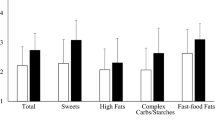Abstract
Few well-controlled trials have evaluated the effects that macronutrient composition has on changes in food cravings during weight loss treatment. The present study, which was part of the Preventing Overweight Using Novel Dietary Strategies (POUNDS LOST) trial, investigated whether the fat and protein content of four different diets affected changes in specific food cravings in overweight and obese adults. A sample of 811 adults were recruited across two clinical sites, and each participant was randomly assigned to one of four macronutrient prescriptions: 1) low fat (20% of energy), average protein (15% of energy); 2) moderate fat (40%), average protein (15%); 3) low fat (20%), high protein (25%); 4) moderate fat (40%), high protein (25%). With few exceptions, the type of diet that participants were assigned did not differentially affect changes in specific food cravings. Participants assigned to the high-fat diets, however, had reduced cravings for carbohydrates at month 12 (p<0.05) and fruits and vegetables at month 24. Also, participants assigned to high-protein diets had increased cravings for sweets at month 6 and month 12 (ps<0.05). Participants in all four dietary conditions reported significant reductions in food cravings for specific types of foods (i.e., high fat foods, fast food fats, sweets, and carbohydrates/starches; all ps<0.05). Cravings for fruits and vegetables, however, were increased at month 24 (p<0.05). Calorically restricted diets (regardless of their macronutrient composition) yielded significant reductions in cravings for fats, sweets, and starches whereas cravings for fruits and vegetables were increased.
Similar content being viewed by others
References
White MA, Whisenhunt BL, Williamson DA, et al. Development and validation of the food-craving inventory. Obes Res 2002; 10: 107–14.
Pelchat ML, Schaefer S. Dietary monotony and food cravings in young and elderly adults. Physiol Behav 2000; 68: 353–9.
Hill AJ, Heaton-Brown L. The experience of food craving: A prospective investigation in healthy women. J Psychosom Res 1994; 38: 801–14.
Weingarten HP, Elston D. Food cravings in a college population. Appetite 1991; 17: 167–75.
Delahanty LM, Meigs JB, Hayden D, et al. Psychological and behavioral correlates of baseline BMI in the diabetes prevention program (DPP). Diabetes Care 2002; 25: 1992–8.
Weingarten HP, Elston D. The phenomenology of food cravings. Appetite 1990;15: 231–46.
Martin CK, O’Neil PM, Tollefson G, et al. The association between food cravings and consumption of specific foods in a laboratory taste test. Appetite 2008; 51: 324–6.
Martin CK, O’Neil PM, Pawlow L. Changes in food cravings during low-calorie and very-low-calorie diets. Obesity (Silver Spring) 2006;14: 115–21.
Gibson EL, Desmond E. Chocolate craving and hunger state: implications for the acquisition and expression of appetite and food choice. Appetite 1999; 32: 219–40.
Mann T, Ward A. Forbidden fruit: Does thinking about a prohibited food lead to its consumption?. Int J Eat Disord 2001; 29: 319–27.
Coelho JS, Polivy J, Herman CP. Selective carbohydrate or protein restriction: effects on subsequent food intake and cravings. Appetite 2006; 47: 352–60.
Martin CK, Rosenbaum D, Han H, et al. Change in food cravings, food preferences, and appetite during a low-carbohydrate and low-fat diet. Obesity (Silver Spring) 2011.
Sacks FM, Bray GA, Carey VJ, et al. Comparison of weight-loss diets with different compositions of fat, protein, and carbohydrates. N Engl J Med 2009; 360: 859–73.
Corty E, McFall RM. Response prevention in the treatment of cigarette smoking. Addict Behav 1984; 9: 405–8.
Niaura RS, Rohsenow DJ, Binkoff JA, et al. Relevance of cue reactivity to understanding alcohol and smoking relapse. J Abnorm Psychol 1988; 97: 133–52.
Rohsenow DJ, Monti PM, Rubonis AV, et al. Cue exposure with coping skills training and communication skills training for alcohol dependence: 6- and 12-month outcomes. Addiction 2001; 96: 1161–74.
Sitharthan T, Sitharthan G, Hough MJ, et al. Cue exposure in moderation drinking: a comparison with cognitive- behavior therapy. J Consult Clin Psychol 1997; 65: 878–82.
Dawe S, Powell J, Richards D, et al. Does post-withdrawal cue exposure improve outcome in opiate addiction? A controlled trial. Addiction 1993; 88: 1233–45.
Blundell JE, Lawton CL, Hill AJ. Mechanisms of appetite control and their abnormalities in obese patients. Horm Res 1993; 39 Suppl 3: 72–6.
Drewnowski A. Metabolic determinants of binge eating. Addict Behav 1995; 20: 733–45.
Hebert JR, Clemow L, Pbert L, et al. Social desirability bias in dietary self-report may compromise the validity of dietary intake measures. Int J Epidemiol 1995; 24: 389–98.
Williamson DA, Anton SD, Han H, et al. Adherence is a multi-dimensional construct in the POUNDS LOST trial. J Behav Med 2010; 33: 35–46.
Author information
Authors and Affiliations
Corresponding author
Rights and permissions
About this article
Cite this article
Anton, S.D., Gallagher, J., Carey, V.J. et al. Diet type and changes in food cravings following weight loss: Findings from the POUNDS LOST Trial. Eat Weight Disord 17, e101–e108 (2012). https://doi.org/10.1007/BF03325333
Received:
Accepted:
Published:
Issue Date:
DOI: https://doi.org/10.1007/BF03325333




